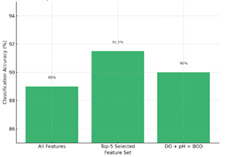Advancements and Challenges in Water Quality Classification Techniques: A Review
Main Article Content
Abstract
Evaluation of water quality is required for the management of water resources and protection of public health. With ever-increasing pollution due to climate change, it has become increasingly challenging to ensure real-time monitoring of the water environment quality. Sampling is necessary for manual water testing and is very time-consuming, was enabled with the setup of IoT sensors. Time-series data generated by the IoT sensors will be analyzed and classified in real-time using ML/DL-based techniques that can detect even the most subtle nuances in water quality parameters such as pH, dissolved oxygen, turbidity, and BOD. Besides anomaly detection and real-time decision support, these automated systems offer a set of additional features like predictive analytics that conventional methods could never provide. CPCB (India) and WHO provide regulatory standards that are followed as the water quality standards. Transfer Learning for data-poor areas, edge computing for real-time analytics, and blockchain for data integrity are some of the few high-level technology enablers on this front. One significant limitation today is the lack of data for water-quality studies besides the real sensor reliability and procedural irregularity over various geographical regions. Further transformations in water quality monitoring can be expected over the horizons of explainable AI and distributed IoT networks, enhancing the platform of its accuracy, transparency, and scalability for better management of global water resources at the end.
Downloads
Article Details

This work is licensed under a Creative Commons Attribution-NoDerivatives 4.0 International License.
